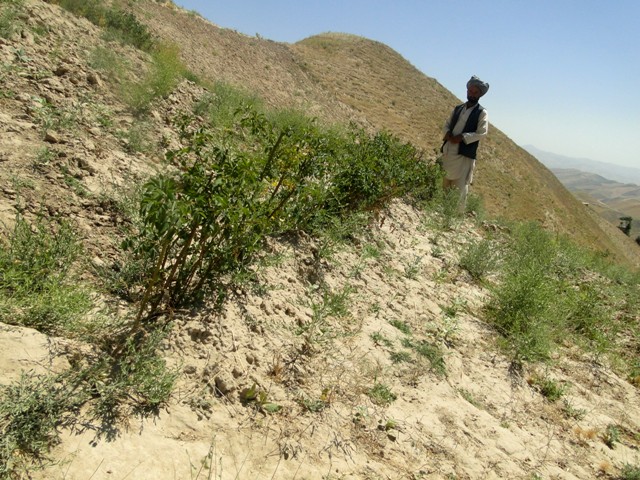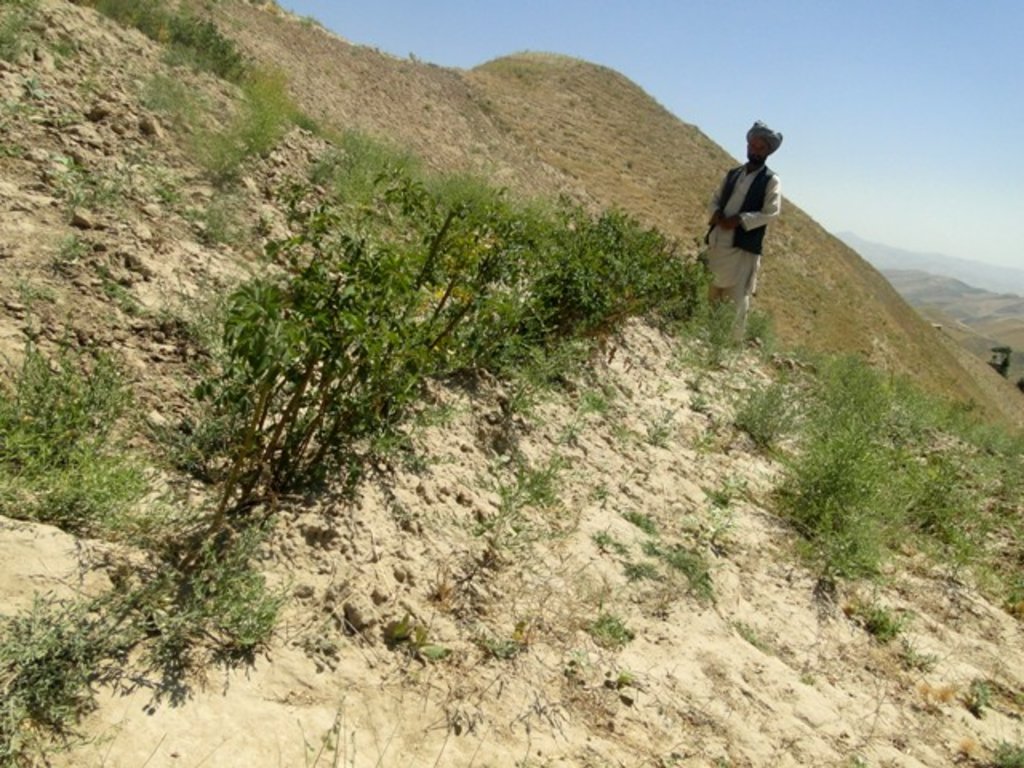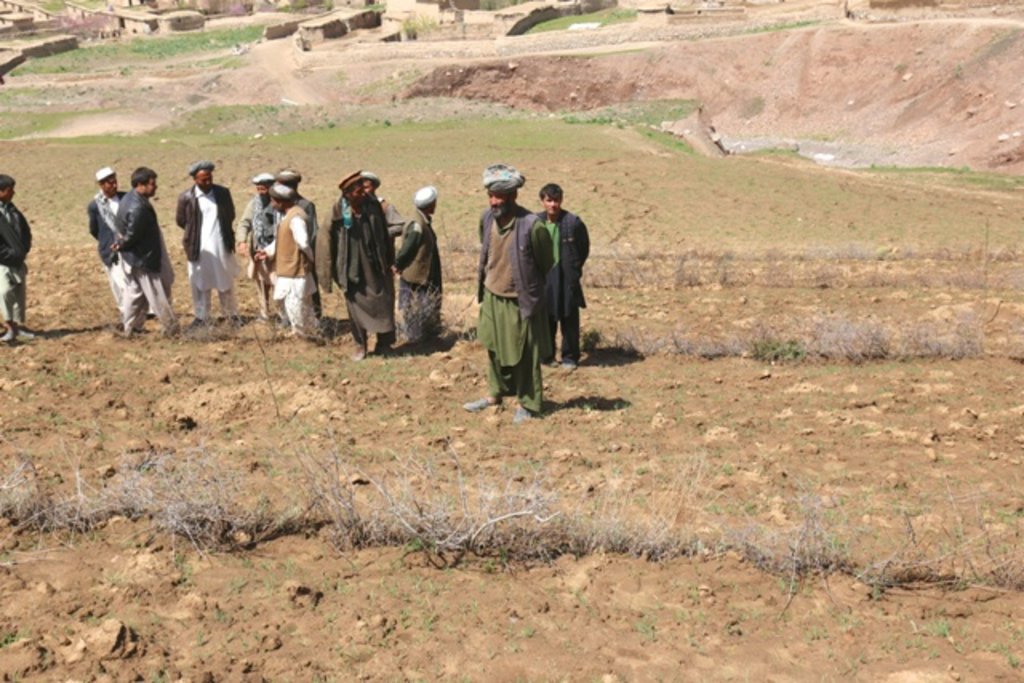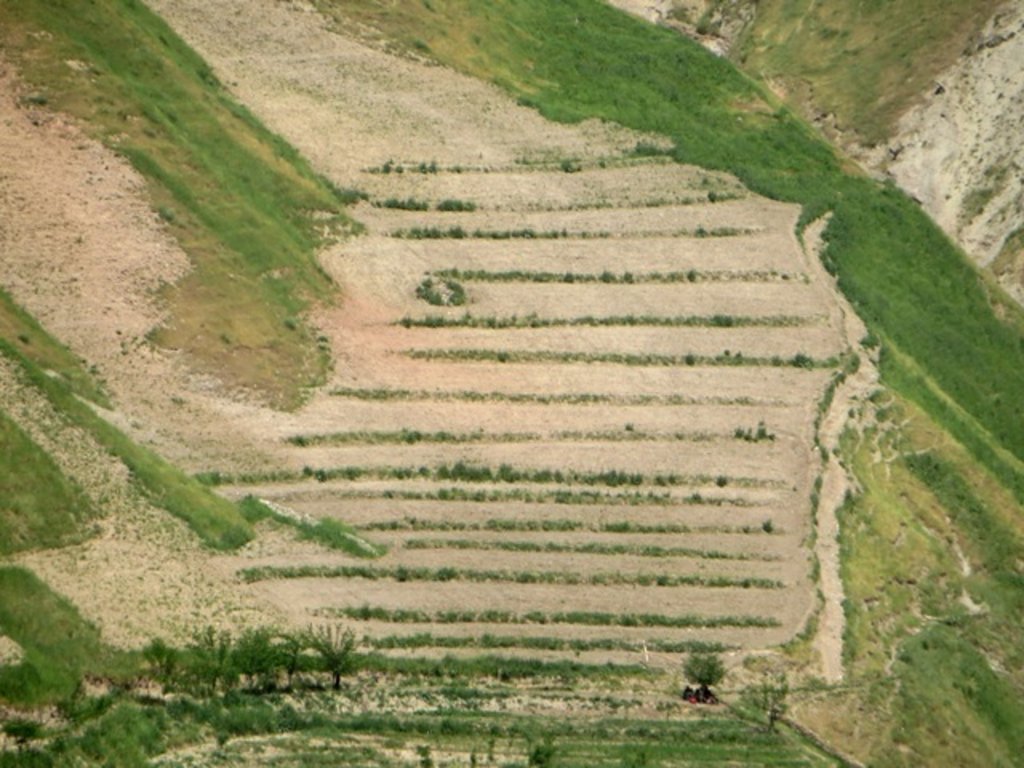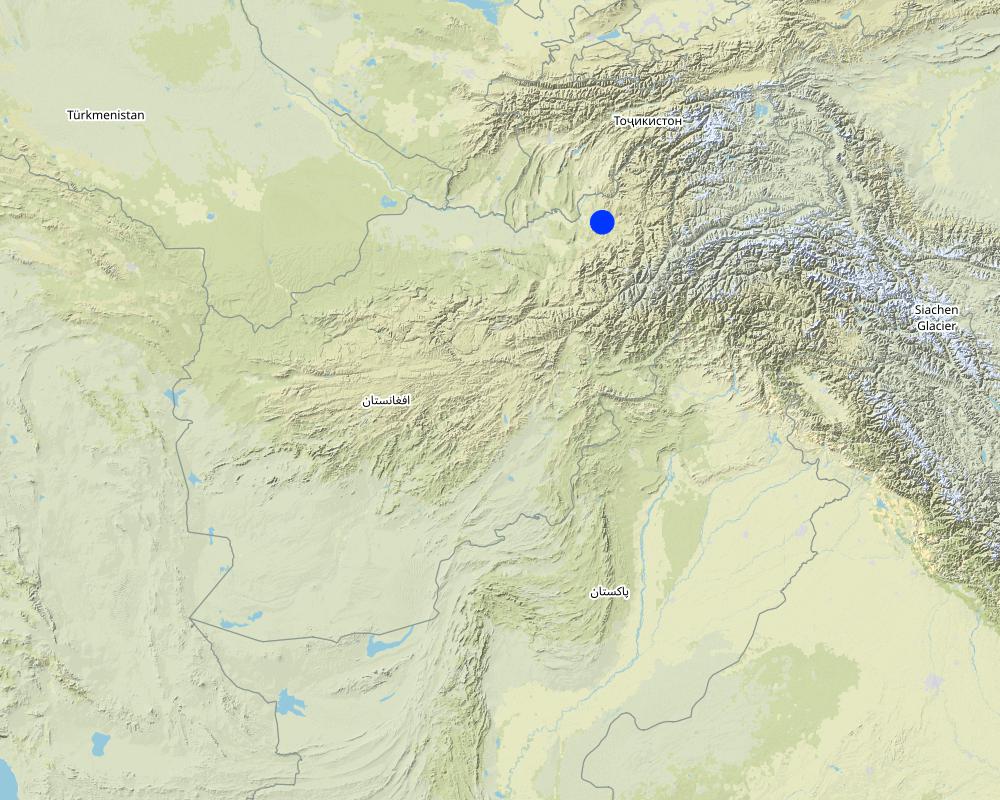Contour hedgerows of alfalfa in annual cropland [Афганистан]
- Шинийг нээх:
- Шинэчлэх:
- Эмхэтгэгч: Bettina Wolfgramm
- Хянан тохиолдуулагчид: Roziya Kirgizbekova, Aslam Qadamov, Aqila Haidery
- Хянагч: William Critchley
Khati sabz, Qamarbandi sabz
technologies_670 - Афганистан
Бүлгүүдийг үзэх
Бүгдийг дэлгэх Бүгдийг хаах1. Ерөнхий мэдээлэл
1.2 Технологийг үнэлэх, баримтжуулах ажилд хамаарах мэдээлэл өгсөн хүмүүс, байгууллагуудын холбоо барих мэдээлэл
Мэдээлэл өгсөн хүн (с)
Газар ашиглагч:
Mohammad Azim Habibullah
Natural Resources Management Comittee (NRMC)
Sari Joy Village, Rustaq District, Takhor Province
Афганистан
ГТМ мэргэжилтэн:
Maroofi Mia Jan
+93 700 019 054
mia.maroofi@gmail.com
Livelihood Improvement Program Takhor Afghanistan
Tdh Office Behind Jamai Masjed, Rustaq Town, Takhor Province
Афганистан
ГТМ мэргэжилтэн:
Researcher:
Технологи баримтжуулах/үнэлэх ажилд дэмжлэг үзүүлсэн төслийн нэр (шаардлагатай бол)
Potential and limitations for improved natural resource management (NRM) in mountain communities in the Rustaq district, Afghanistan (Rustaq NRM Study)Технологи баримтжуулах/үнэлэх ажилд дэмжлэг үзүүлсэн төслийн нэр (шаардлагатай бол)
Livelihood Improvement Project Takhar, Afghanistan (LIPT)Технологи баримтжуулах/үнэлэх ажилд дэмжлэг үзүүлсэн байгууллага(ууд)-ын нэр (шаардлагатай бол)
Terre des Hommes (Terre des Hommes) - ШвейцарТехнологи баримтжуулах/үнэлэх ажилд дэмжлэг үзүүлсэн байгууллага(ууд)-ын нэр (шаардлагатай бол)
Swiss Agency for Development and Cooperation (DEZA / COSUDE / DDC / SDC) - ШвейцарТехнологи баримтжуулах/үнэлэх ажилд дэмжлэг үзүүлсэн байгууллага(ууд)-ын нэр (шаардлагатай бол)
CDE Centre for Development and Environment (CDE Centre for Development and Environment) - ШвейцарТехнологи баримтжуулах/үнэлэх ажилд дэмжлэг үзүүлсэн байгууллага(ууд)-ын нэр (шаардлагатай бол)
Bern University of Applied Sciences, School of Agricultural, Forest and Food Sciences (HAFL) - Швейцар1.3 ВОКАТ-аар баримтжуулсан өгөгдлийг ашиглахтай холбоотой нөхцөл
Мэдээллийг хэзээ (газар дээр нь) цуглуулсан бэ?
27/10/2016
Эмхэтгэгч болон гол мэдээлэгч хүн(хүмүүс) WOCAT аргачлалаар баримтжуулсан мэдээллийг ашиглахтай холбоотой нөхцлийг хүлээн зөвшөөрсөн:
Тийм
1.4 Технологи тогтвортой гэдгийг баталгаажуулах
Энэ технологийг газрын доройтлыг бууруулж, газрын тогтвортой менежментийг хангахад тохиромжтой гэж үзэж болох уу?
Үгүй
Тайлбар:
SLM practices documented in the frame of the Rustaq NRM study were established only recently (1-3 years ago). It is too early for a final judgment on the sustainability of these technologies within the human and natural environment of Chokar watershed.
2. ГТМ Технологийн тодорхойлолт
2.1 Технологийн товч тодорхойлолт
Технологийн тодорхойлолт:
Hedgerows are vegetative strips of perennial grasses, shrubs or legumes - such as alfalfa - located along contours across a slope. These vegetative strips form a barrier to halt soil erosion and improve soil fertility. Hedgerows of alfalfa also provide quality animal fodder for a period of 5-10 years.
2.2 Технологийн дэлгэрэнгүй тодорхойлолт
Тодорхойлолт:
Project supported implementation of hedgerows has taken place in the villages of Sari Joy and Jawaz Khana, located in Chokar watershed of Rustaq District in Northern Afghanistan. The Chokar watershed is a mountainous area situated between 600 m and 2,500 m above sea level. The climate is semi-arid with harsh and cold weather in winter and hot and dry summers. The annual precipitation in average years is 580mm. Land degradation affects all forms of land use and includes sparse vegetation cover, severe top soil erosion through rainfall runoff, and poor soil fertility. Unsustainable agricultural practices, and over-exploitation of the natural resources are adversely impacting the socio-economic well-being of local communities, as well as contributing to the risk of being adversely affected by drought, landslides and flash foods triggered by heavy rainfall. The data used for the documentation of the technology are based on field research conducted in Chokar watershed, namely in the villages of Sari Joy and Jawaz Khana. These villages represent the upper and the middle zone of Chokar watershed, respectively. They differ considerably in access to services and infrastructure, but in general are poorly served. The communities depend on land resources for sustaining their livelihoods. In a good year with high yields, wheat self-sufficiency lasts about 5 months. The three villages are home to ethnic Qarluq communities. Since 2012 the Livelihood Improvement Project Takhar (LIPT) implemented by Terre des hommes (Tdh) Switzerland has initiated a range of NRM interventions.
Hedgerows are vegetative strips, planted as contour barriers. In this case they are composed of the perennial legume alfalfa (sometime called lucerne: Medicago sativa), Using an A-frame, contours are defined and demarcated horizontally across the hillside. The distance between the contours depends on the slope gradient. For moderate slopes above 6%, and hilly slopes below 30%, the distance between the contours is 4-5 meters. Using such contouring measurements, a plot area of 0.2 ha is divided into 8 hedgerows along the slope. Once all the contours are established, the topsoil is levelled using a shovel. On each marked contour a soil ridge is created, some 10-20 cm high. On these ridges alfalfa seeds are sown to form the vegetative hedgerow. This stops soil wash, and prevents most of the rainfall runoff. The area between the grass strips is cropped with wheat. The hedgerows are protected for one year, to allow the alfalfa to become established.
Hedgerows were introduced in the local villages to promote low-cost land management practices, which are sustainable and well adapted to the local environmental conditions. Apart from reducing soil erosion, this new practice takes into account the needs of local people to improve soil fertility and increase agricultural yields. Local land users were trained to establish hedgerows on their own land using low amount of inputs. They were given the technical knowledge required. Over the past four years of implementation the land users report noticeable improvements on their plots. The soil is protected from erosion, and the households harvest wheat for the family and alfalfa for their livestock.
One of the key benefits of the technology is that it does not require many or costly inputs and it is relatively easy to establish without technical support. Improved production and availability of alfalfa is a primary benefit from the land users' point of view. They can harvest fodder from the plot for up to 10 years without reseeding.
Hedgerows are among the least labour-intensive SLM practices and thereby do not have a significant influence on the daily household workload of local women. This feature of the technology is perceived as its strength by many female family members.
2.3 Технологийн гэрэл зураг
2.5 Энэ үнэлгээнд хамрагдсан технологийг хэрэгжүүлсэн улс орон/ бүс нутаг/ байршил
Улс:
Афганистан
Улс/аймаг/сум:
Takhar Province, Rustaq District
Байршлын дэлгэрэнгүй тодорхойлолт:
Sari Joy and Jawaz Khana Villages
Тайлбар:
This documentation is based on the experiences of SLM implementers from Sari Joy (3 plots) and Jawaz Khana, (3 plots) as compiled during FGDs. Additionally insights were gained through interviews in the villages on farmers experiences and observations of hedgerow plots, with both SLM implementers (5) and observers (7).
Map
×2.6 Хэрэгжсэн хугацаа
Байгуулсан тодорхой оныг мэдэхгүй бол баримжаа хугацааг тодорхойл:
- <10 жилийн өмнө (саяхны)
2.7 Технологийн танилцуулга
Технологийг хэрхэн нэвтрүүлснийг тодорхойл:
- Гадны төсөл/хөтөлбөрийн дэмжлэгтэйгээр
Тайлбар (төслийн төрөл г.м.):
Livelihood Improvement Project Takhar (LIPT) implemented by Terre des Hommes (Tdh) Switzerland, supported by Swiss Development Cooperation (SDC) from 2012-17
3. ГТМ технологийн ангилал
3.1 Технологийн үндсэн зорилго (ууд)
- үйлдвэрлэлийг сайжруулах
- газрын доройтлыг бууруулах, сэргийлэх, нөхөн сэргээх
3.2 Технологи нэвтрүүлсэн газрын одоогийн газар ашиглалтын хэлбэр(үүд)

Холимог (тариалан/бэлчээр/мод), үүнд. ХАА-н ойжуулалт
- ХАА-н ойжуулалт
Гол бүтээгдэхүүн/ үйлчилгээ:
Alfalfa, wheat (ferula in later years)
3.3 Газар ашиглалтын тухай нэмэлт мэдээлэл
Технологи хэрэгжүүлсэн газрын усан хангамж:
- Байгалийн усалгаатай
Жилд ургамал ургах улирлын тоо:
- 1
3.4 Технологи ГТМ-ийн аль бүлэгт хамаарах вэ
- Хөрсний үржил шимийн нэгдсэн менежмент
- Налуугийн арга хэмжээ
3.5 Технологийн хамрах талбай
Технологи өргөн дэлгэрсэн эсхийг тодорхойл:
- газар дээр жигд тархсан
Технологи газар нутгийн хэмжээнд жигд тархсан бол түүний эзлэх талбайг дундажаар тооцож тэмдэглэ:
- 0.1-1 км2
3.6 Технологийг бүрдүүлэх ГТМ арга хэмжээ

Ургамлын арга хэмжээ
- V1: Мод ба бут, сөөг

Барилга байгууламжийн арга хэмжээ

Менежментийн арга хэмжээ
- М1: Газар ашиглалтын хэлбэрийг өөрчлөх
Тайлбар:
After establishment activities the area is put on quarantine for one year.
3.7 Технологид харгалзах газрын доройтлын төрөл

хөрс усаар эвдрэх
- Wt: Хөрсний гадаргын угаагдал

хөрс салхиар эвдрэх
- Et: Хөрсний гадаргын зөөгдөл

биологийн доройтол
- Bc: Ургамлан нөмрөг багасах
- Bq: биомасс буурах
3.8 Газрын доройтлоос урьдчилан сэргийлэх, сааруулах ба нөхөн сэргээх
Газрын доройтолтой холбоотойгоор Технологи ямар зорилго тавьсан болохыг тодорхойл:
- Газрын доройтлыг бууруулах
4. Техникийн нөхцөл, хэрэгжүүлсэн үйл ажиллагаа, материал ба зардал
4.1 Технологийн техник зураг
Зохиогч:
Aslam Qadamov; Roziya Kirgizbekova
Он, сар, өдөр:
15/02/2017
4.2 Техникийн үзүүлэлт/ техникийн зургийн тайлбар
Hedgerows are vegetative strips, planted as contour barriers. In this case they are composed of the perennial legume alfalfa (sometime called lucerne: Medicago sativa), Using an A-frame, contours are defined and demarcated horizontally across the hillside. The distance between the contours depends on the slope gradient. For moderate slopes above 6%, and hilly slopes below 30%, the distance between the contours is 4-5 meters. Using such contouring measurements, a plot area of 0.2 ha is divided into 8 hedgerows along the slope. Once all the contours are established, the topsoil is levelled using a shovel. On each marked contour a soil ridge is created, some 10-20 cm high. On these ridges alfalfa seeds are sown to form the vegetative hedgerow. This stops soil wash, and prevents most of the rainfall runoff. The area between the grass strips is cropped with wheat. The hedgerows are protected for one year, to allow the alfalfa to become established.
4.3 Материал болон зардалд хамаарах ерөнхий мэдээлэл
Үнэ өртөг, оруулсан хувь нэмрийг хэрхэн тооцсоныг тодорхойл:
- Технологийн нэгж тус бүр
Талбайн хэмжээ ба нэгжийг тодорхойл:
1 ha
Үнэ өртөгийг тооцоход ашигласан мөнгөн нэгж:
- Америк доллар
Ам.доллар ба үндэсний мөнгөн нэгж хоорондын хөрвөх үнийг тодорхойл (шаардлагатай бол): 1 USD =:
67.0
Хөлсний ажилчны нэг өдрийн цалингийн хэмжээг тодорхойлно уу:
5.2-5.3 USD per day
4.4 Бий болгох үйл ажиллагаа
| Үйл ажиллагаа | Арга хэмжээний төрөл | Хугацаа | |
|---|---|---|---|
| 1. | Selection of the area for establishing a hedgerow | Менежментийн | End of autumn |
| 2. | Design of the hedgerows using an A-frame | Барилга байгууламжийн | End of autumn |
| 3. | Leveling of the land | Агрономийн | End of autumn |
| 4. | Alfalfa seed sowing | Ургамлын | End of winter (February) |
| 5. | Area under protection | Менежментийн | For one year |
4.5 Бий болгоход шаардагдсан зардал, хөрөнгийн өртөг
| Зардлын нэр, төрөл | Хэмжих нэгж | Тоо хэмжээ | Нэгжийн үнэ | Зардал бүрийн нийт өртөг | Нийт дүнгээс газар ашиглагчийн төлсөн % | |
|---|---|---|---|---|---|---|
| Хөдөлмөр эрхлэлт | Designing of the hedgerow using A-frame | person-day | 5.0 | 9.0 | 45.0 | |
| Хөдөлмөр эрхлэлт | Leveling the land | person-day | 25.0 | 5.3 | 132.5 | |
| Хөдөлмөр эрхлэлт | Ploughing the land with animal traction | person-day | 5.0 | 5.3 | 26.5 | |
| Хөдөлмөр эрхлэлт | Wheat and Alfalfa seed sowing | person-day | 10.0 | 5.3 | 53.0 | 100.0 |
| Тоног төхөөрөмж | Rake | piece | 1.0 | 5.3 | 5.3 | |
| Тоног төхөөрөмж | Shovel | piece | 1.0 | 3.8 | 3.8 | |
| Тоног төхөөрөмж | Twine | meter | 50.0 | 2.0 | 100.0 | |
| Тоног төхөөрөмж | A-frame | piece | 1.0 | 6.0 | 6.0 | |
| таримал материал | Alfalfa seed | Kg | 17.5 | 0.42 | 7.35 | |
| таримал материал | Wheat seed | Kg | 140.0 | 0.42 | 58.8 | 100.0 |
| Бордоо ба биоцид | DAP | Kg | 250.0 | 0.9 | 225.0 | |
| Бордоо ба биоцид | Urea | Kg | 250.0 | 0.45 | 112.5 | |
| Бордоо ба биоцид | Herbicide | Liter | 50.0 | 0.25 | 12.5 | |
| Технологи бий болгох нийт үнэ өртөг | 788.25 | |||||
Хэрэв газар ашиглагч нийт зардлын 100% -иас бага хэсгийг төлсөн бол хэн голлох зардлыг гаргасан бэ:
Livelihood Improvement Program in Takhar (LIPT) implemented by Terre des hommes (Tdh)
Тайлбар:
Costs calculated for a Technology area of 1ha was only done for the purpose of the WOCAT documentation. In reality SLM plots are on average 0.2-0.4 ha or 1-2 jiribs. Costs were simply multiplied by 2.5. The actual costs for a 1ha plot might be slightly different.
4.6 Арчилгаа/ урсгал үйл ажиллагаа
| Үйл ажиллагаа | Арга хэмжээний төрөл | Хугацаа/ давтамж | |
|---|---|---|---|
| 1. | Ploughing the land with animal traction (Men) | Агрономийн | |
| 2. | Wheat sowing | Агрономийн | |
| 3. | Weeding | Агрономийн | |
| 4. | Fertilizer application | Агрономийн | |
| 5. | Repair the damaged section of the hedgerow by adding soil | Барилга байгууламжийн | End of winter (February/March) |
| 6. | Reseeding alfalfa in the repaired section | Ургамлын | End of winter (February/March) |
| 7. | Wheat and alfalfa harvesting and delivering | Агрономийн |
Тайлбар:
Sowing of alfalfa is done once in 5-10 years. The maintenance activities do not require reseeding of alfalfa every year (only where damaged). Mostly damage to hedgerows occur as a result of heavy rainfall and require maintenance work in early spring.
4.7 Арчилгаа/урсгал ажилд шаардагдсан зардал, хөрөнгийн өртөг (нэг жилд)
| Зардлын нэр, төрөл | Хэмжих нэгж | Тоо хэмжээ | Нэгжийн үнэ | Зардал бүрийн нийт өртөг | Нийт дүнгээс газар ашиглагчийн төлсөн % | |
|---|---|---|---|---|---|---|
| Хөдөлмөр эрхлэлт | Ploughing the land with animal traction | person day | 5.0 | 5.3 | 26.5 | 100.0 |
| Хөдөлмөр эрхлэлт | Sowing of wheat | person day | 5.0 | 5.3 | 26.5 | 100.0 |
| Хөдөлмөр эрхлэлт | Weeding and Fertilizer application | person day | 5.0 | 5.3 | 26.5 | 100.0 |
| Хөдөлмөр эрхлэлт | Harvesting and delivering wheat and alfalfa | person day | 35.0 | 3.0 | 105.0 | 100.0 |
| Тоног төхөөрөмж | Sickle | Pcs | 1.0 | 2.25 | 2.25 | 100.0 |
| Тоног төхөөрөмж | Pitchfork | Pcs | 1.0 | 5.3 | 5.3 | 100.0 |
| таримал материал | Alfalfa seed | kg | 1.0 | 0.42 | 0.42 | 100.0 |
| таримал материал | Wheat seed | kg | 140.0 | 0.42 | 58.8 | 100.0 |
| Бордоо ба биоцид | DAP | Kg | 250.0 | 0.9 | 225.0 | 100.0 |
| Бордоо ба биоцид | Urea | Kg | 250.0 | 0.45 | 112.5 | 100.0 |
| Технологийн арчилгаа/урсгал үйл ажиллагаанд шаардагдах нийт үнэ өртөг | 588.77 | |||||
Хэрэв газар ашиглагч нийт зардлын 100% -иас бага хэсгийг төлсөн бол хэн голлох зардлыг гаргасан бэ:
Livelihood Improvement Program in Takhar (LIPT) implemented by Terre des hommes (Tdh)
Тайлбар:
Costs calculated for a Technology area of 1ha was only done for the purpose of the WOCAT documentation. In reality SLM plots are on average 0.2-0.4 ha or 1-2 jiribs. Costs were simply multiplied by 2.5. The actual costs for a 1ha plot might be slightly different.
4.8 Зардалд нөлөөлж байгаа хамгийн чухал хүчин зүйл
Өртөг, зардалд нөлөөлөх гол хүчин зүйл:
Due to the remoteness of the villages where the Technology has been implemented, all the inputs for establishment, such as plant material, fertilizers and agricultural tools are purchased in Rustaq town. The expenses for traveling and delivering the inputs affect the establishment costs.
5. Байгаль ба нийгмийн нөхцөл
5.1 Уур амьсгал
Жилийн нийлбэр хур тундас
- < 250 мм
- 251-500 мм
- 501-750 мм
- 751-1,000 мм
- 1,001-1,500 мм
- 1,501-2,000 мм
- 2,001-3,000 мм
- 3,001-4,000 мм
- > 4,000 мм
Жилийн дундаж хур тунадас (хэрэв мэдэгдэж байвал), мм:
564.00
Хур тунадасны талаархи тодорхойлолт/ тайлбар:
Average annual precipitation for the area was calculated with 564 mm, with minimum in dry years (2000 and 2001) of 270 mm and maximum in wet years (2009/2010) of 830 mm. The absolute maximum rainfall was calculated for 1986 with 1024 mm. The data series covers the period from 1979 to 2014.
Холбогдох цаг уурын станцын нэр:
Climate Forecast System Reanalysis (CFSR), http://rda.ucar.edu/pub/cfsr.html
Агро-уур амьсгалын бүс
- хагас хуурай
Derived from the publicly available dataset on length of growing period (LGP) (Fischer 2009 / IIASA-FAO). Internet link: http://tiles.arcgis.com/tiles/P8Cok4qAP1sTVE59/arcgis/rest/services/Length_of_growing_period/MapServer
5.2 Гадаргын хэлбэр
Дундаж налуу:
- хавтгай (0-2 %)
- бага зэрэг налуу (3-5 %)
- дунд зэрэг налуу (6-10 % )
- хэвгий (11-15 %)
- налуу (16-30 %)
- их налуу (31-60 % )
- эгц налуу (>60 %)
Гадаргын хэлбэр:
- тэгш өндөрлөг / тал
- нуруу
- уулын энгэр
- дов толгод
- бэл
- хөндий
Өндрийн бүслүүр:
- 0-100 д.т.д. м.
- 101-500 д.т.д. м.
- 501-1,000 д.т.д м.
- 1,001-1,500 д.т.д м.
- 1,501-2,000 д.т.д м.
- 2,001-2,500 д.т.д. м.
- 2,501-3,000 д.т.д. м.
- 3,001-4,000 д.т.д м.
- > 4,000 д.т.д. м.
Гадаргын талаархи тодорхойлолт ба бусад тайлбар:
-SLM implementers information provided in the Land User Protocol (LUP) during an FGD
-Elevation and slope statistics derived for terraced plots from ASTGTM. ASTGTM is the ASTER Global Digital Elevation Model V002 with a 30 m spatial resolution. More information on ASTGTM is available here: https://lpdaac.usgs.gov/node/1079. The data can be downloaded here: https://gdex.cr.usgs.gov/gdex/
5.3 Хөрс
Хөрсний дундаж зузаан:
- маш нимгэн (0-20 см)
- нимгэн (21-50 см)
- дунд зэрэг зузаан (51-80 см)
- зузаан (81-120 cм)
- маш зузаан (>120 cм)
Хөрсний бүтэц (өнгөн хөрс):
- дундаж (элсэнцэр, шавранцар)
Хөрсний бүтэц (>20 см-ээс доош):
- дундаж (элсэнцэр, шавранцар)
Өнгөн хөрсөнд агуулагдах ялзмаг:
- бага (<1 % )
Боломжтой бол хөрсний бүрэн тодорхойлолт, боломжит мэдээллийг өгнө үү, жишээ нь хөрсний төрөл, хөрсний урвалын орчин/хүчиллэг байдал, катион солилцох чадавхи, азотын хэмжээ, давсжилт г.м.
Hedgerows are implemented on light soil - a locally defined category for soil types. Light soil corresponds to moderately deep soil; medium topsoil texture; medium below surface texture and low topsoil organic matter.
5.4 Усны хүртээмж ба чанар
Гүний усны түвшин:
5-50 м
Гадаргын усны хүртээмж:
дунд зэрэг
Усны чанар (цэвэршүүлээгүй):
сайн чанарын ундны ус
Усны давсжилтын асуудал бий юу?
Үгүй
Энэ газар үерт автдаг уу?
Тийм
Тогтмол байдал:
тохиолдлын
Усны чанар, нөөцийн талаархи тайлбар ба бусад тодорхойлолт:
Floods occur mainly during the rainy seasons in spring and autumn. Availability of surface water differs for the two study villages Sari Joy and Jawaz Khana. Sari Joy has relatively good surface water availability, also for drinking. Jawaz Khana has poor water both in quality and availability. Water has to be fetched from a lower lying stream.
5.5 Биологийн олон янз байдал
Зүйлийн олон янз байдал:
- Бага
Амьдрах орчны олон янз байдал:
- Бага
5.6 Технологи нэвтрүүлсэн газар ашиглагчдын тухай мэдээлэл
Суурьшмал эсвэл нүүдлийн:
- Суурьшмал
Үйлдвэрлэлийн системийн зах зээлийн чиг баримжаа:
- амь зуух арга хэлбэрийн (өөрийгөө хангах)
- холимог (амь зуух/ худалдаа наймаа
Бусад эх үүсвэрээс олох орлого:
- Нийт орлогын 10-50 %
- Нийт орлогын 50 %-иас дээш
Чинээлэг байдлын түвшин:
- ядуу
- чинээлэг
Хувь хүн эсвэл бүлэг:
- Хувь хүн / өрх
Механикжилтын түвшин:
- гар ажил
- ердийн хөсөг
Хүйс:
- эмэгтэй
- эрэгтэй
Газар ашиглагчийн нас:
- хүүхэд
- дунд нас
Газар ашиглагчдын бусад шинж чанарыг тодорхойл:
The land users in the area where the Technology is applied belong to the Uzbek ethnic minority group Qarluq. Although the men are generally the main land users, however, women and children also take active part in the related work. The functions of men and women are clearly distinguished within the Afghan society. At the same time within the family this division of work and functions also results in men and women working hand-in-hand. An improvement of the family’s livelihood situation is expected to positively affect all family members. While, it is recognized that the involvement of women is key in order to secure basic human rights for everyone, to achieve good governance, sustainable development, and to efficiently contribute to poverty reduction (SDC 2004), it is also clear that a context sensitive approach is of great importance.
Women in rural Afghanistan are involved in many production and income generating activities that contribute to the overall household income, however, very few women own resources such as land and livestock, and their income generating options are fewer in comparison to that of men.
5.7 Технологи нэвтрүүлсэн газар ашиглагчийн өмчилж буй, эзэмшиж буй, түрээсэлж буй эсвэл ашиглаж буй (ашиглах эрх) газрын талбай
- < 0.5 га
- 0.5-1 га
- 1-2 га
- 2-5 га
- 5-15 га
- 15-50 га
- 50-100 га
- 100-500 га
- 500-1,000 га
- 1,000-10,000 га
- > 10,000 га
Энэ талбай том, жижиг, дунд алинд хамаарах вэ (орон нутгийн нөхцөлд харгалзуулна уу)?
- дунд-хэмжээний
5.8 Газар эзэмшил, газар ашиглах эрх, ус ашиглах эрх
Газар өмчлөл:
- хувь хүн, өмчийн гэрчилгээгүй
Газар ашиглах эрх:
- хувь хүн
Ус ашиглах эрх:
- нэгдлийн хэлбэрээр (зохион байгуулалттай)
Тайлбар:
Those who own a land and use water for irrigation are obliged to pay for water. The payment is made either in kind or in cash to Mirob - the person in charge of distributing water in the community. The amount of the payment varies from village to village.
6. Үр нөлөө ба дүгнэлт
6.1 Технологийн талбайд үзүүлсэн нөлөө
Нийгэм-эдийн засгийн үр нөлөө
Үйлдвэрлэл
газар тариалангийн үйлдвэрлэл
Тайлбар/ тодорхой дурьдах:
Wheat grows well on the plot where the contour strips support moisture retention, as well as prevent the seeds and fertilizers to be washed off.
тэжээл үйлдвэрлэл
Тайлбар/ тодорхой дурьдах:
Alfalfa is produced on the hedgerows to ensure stable supply of livestock fodder.
малын бүтээмж
Тайлбар/ тодорхой дурьдах:
The livestock of the household benefit from the improved production of alfalfa as a fodder crop.
модлогийн бүтээмж
ойн дагалт баялгийн бүтээмж
бүтээгдэхүүний олон янз хэлбэр
үйлдвэрлэлийн газар
Нийгэм-соёлын үр нөлөө
ГТМ/ газрын доройтлын мэдлэг
Тайлбар/ тодорхой дурьдах:
Land users learned how to implement SLM practices.
нийгэм, эдийн засгийн хувьд эмзэг бүлгийнхний нөхцөл байдал
Тайлбар/ тодорхой дурьдах:
Female headed households are not included. Technology is implemented on private land, therefore people without land are excluded. However, they have the opportunity to earn income as a hired worker for the SLM implementers.
Экологийн үр нөлөө
Усны эргэлт/ илүүдэл
гадаргын урсац
Хөрс
хөрс алдагдах
Биологийн олон янз байдал: ургамал, амьтан
Ургамалын бүрхэвч
6.2 Технологийн талбайн гадна үзүүлсэн үр нөлөө
голын адагт үерлэх
голын адагт лаг шавар хуримтлагдах
буферлэх / шүүлтүүрийн багтаамж
Нөлөөллийн үнэлгээнд хамаарах нэмэлт тайлбар:
Based on the Land User Protocols: SLM implementers were asked to rate the benefits from hedgerows individually. They were asked to indicate production increase of crops; fodder; animals; wood; non-wood forest products; increase in product diversity; or production area. The most important increase they rated with 3, the second most with 2, others with 1 point. Averages of the points given by all hedgerow implementers are reflected here.
Based on the Land User Protocols: Individual SLM implementers were asked to rate the on-site and off-site impacts of the Technology on water; soil; and vegetation. They were asked to indicate the strength of impacts with three, two or one points. Averages of the points given by all implementers are reflected here.
6.3 Технологийн уур амьсгалын өөрчлөлт, цаг агаарын гамшигт үзэгдэлд өртөх байдал ба эмзэг байдал (газар ашиглагчийн бодлоор)
Уур амьсгалаас хамаарах аюул (гамшиг)
Цаг уурын гамшигт үзэгдэл
| Технологи түүний нөлөөг хэрхэн бууруулж байна? | |
|---|---|
| орон нутгийн аадар бороо | маш сайн |
Уур амьсгалын гамшиг
| Технологи түүний нөлөөг хэрхэн бууруулж байна? | |
|---|---|
| ган гачиг | сайн |
Тайлбар:
Based on the multi-criteria matrix: SLM implementers were asked to jointly discuss and rate how much the SLM technology reduced the lands vulnerability to drought and local rainstorms. Only vulnerability to the most prevalent climate extremes (drought and local rainstorms) was discussed. SLM technologies were rated as reducing vulnerability poorly, well, or very well. The average points reflected here are from multi-criteria matrixes compiled in three villages where the SLM technology had been implemented.
6.4 Өртөг ба ашгийн шинжилгээ
Бий болгох зардалтай харьцуулахад ямар ашиг өгсөн бэ (газар ашиглагчийн бодлоор)?
Богино хугацаанд эргэн төлөгдөх байдал:
эерэг
Урт хугацаанд эргэн төлөгдөх байдал:
эерэг
Тайлбар:
SLM implementers from three villages were asked to jointly discuss and rate the SLM technologies short term (1-3 years) and long-term (10 years) return. As most of the technologies have only been implemented 1-2 years ago, it is too early to compare benefits to maintenance costs. Farmers have little experience so far on the actual benefits of the SLM technologies. The ratings are mostly based on expected benefits and not on actual benefits.
6.5 Технологи нэвтрүүлэлт
- жишээ/ туршилт
Боломжтой бол, тоогоор илэрхийл (өрхийн тоо эсвэл бүрхэх талбай):
16.4 ha
Тайлбар:
Based on the Land User Protocol: Individual SLM implementers were asked whether they received support for implementing the Technology. Each indicated the type of support he received from the proposed options: "Full Support 100%, Some Support, No Support 0%".
6.6 Дасан зохицох
Бий болсон өөрчлөлтөд зохицуулан технологийг өөрчилсөн үү?
Үгүй
6.7 Технологийн давуу тал/боломжууд
| Газар ашиглагчдын тодорхойлсон давуу тал/боломжууд |
|---|
| The contour alfalfa strips preserve moisture and makes the land less vulnerable to dry spells. Longer moisture retention also helps the crop to grow better. |
| Production of livestock fodder such as alfalfa has been improved as observed by the land users. The hedgerow protects the soil from heavy rainfall, which would wash off the topsoil otherwise. |
| The establishment and maintenance activities are well compatible with the daily work of the land user compared to other more demanding field work. |
| Alfalfa can be grown without reseeding for up to 5 years and there is no need to buy alfalfa seeds every year. |
| Hedgerows are considered as the least labour-intensive technology for women and does not impact their daily household activities. |
| Эмхэтгэгч, бусад мэдээлэл өгсөн хүмүүсийн өнцгөөс тодорхойлсон давуу тал/боломжууд |
|---|
| The establishment of hedgerows is not very technically demanding and does not require great technical knowledge |
6.8 Технологийн дутагдалтай/сул тал/аюул болон тэдгээрийг хэрхэн даван туулах арга зам
| Газар ашиглагч нарын тодорхойлсон сул тал/ дутагдал/ эрсдэл | Тэдгээрийг хэрхэн даван туулах вэ? |
|---|---|
| The costs of establishment are high for the land user, including the labour and material inputs | |
| The alfalfa strips need to be reseeded in 5-10 years and the land user may not have the seeds and has to buy them himself |
| Эмхэтгэгч, бусад мэдээлэл өгсөн хүмүүсийн өнцгөөс тодорхойлсон сул тал/ дутагдал/ эрсдэл | Тэдгээрийг хэрхэн даван туулах вэ? |
|---|---|
| Hedgerows are among least popular practices among the land users and the adoption rates have been very low. The reasons behind might be the high establishments costs. |
7. Ном зүй ба холбоосууд
7.1 Мэдээлэл цуглуулсан арга/эх үүсвэр
- Хээрийн уулзалт, судалгаа
No field work was conducted.
- Газар ашиглагчтай хийсэн ярилцлага
Focus group discussions (FGD) were organized by the CDE team to collect information from SLM implementers. Total of 6 land users who have implemented hedgerows participated in the FGDs held in the villages of Sari Joy and Jawaz Khana.
Interviews were conducted by the HAFL team to collect information from persons representing all the three study villages. Very detailed interviews were conducted with 12 persons interested in hedgerows implementation, of which 5 persons are from households that already have implemented hedgerows.
- ГТМ-ийн мэргэжилтэн/шинжээчтэй хийсэн ярилцлага
Close collaboration took place during the compilation of this material with the technical staff of the LIPT project in Rustaq.
- тайлан болон бусад эх сурвалжийн бүрдэл
Information provided in the reports of the LIPT project in Rustaq served as an initial source of information during the preparatory phase and also solidifying the description of the technology and area of implementation. Other background papers on Afghanistan were referred to for general information on agriculture and natural resource management in Afghanistan.
7.2 Ном, хэвлэлийн ишлэл
Гарчиг, зохиогч, он, ISBN:
Guidelines for Focus Groups Discussions
Гарчиг, зохиогч, он, ISBN:
Methods section of the Rustaq NRM study
Холбоос ба модулууд
Бүгдийг дэлгэх Бүгдийг хаахХолбоосууд
Холбоос байхгүй байна
Модулууд
Модуль байхгүй байна


